
Dunfermline is a city, parish, former Royal burgh in Fife, Scotland, 3 miles (5 km) from the northern shore of the Firth of Forth. Dunfermline was the de facto capital of the Kingdom of Scotland between the 11th and 15th centuries.

Inverkeithing is a coastal town, parish and historic royal burgh in Fife, Scotland, on the Firth of Forth, 9.5 miles northwest of Edinburgh city centre and 4 miles south of Dunfermline.

The Falkirk Steeple is a municipal building on the High Street in Falkirk in Scotland. The building, which accommodates a heritage centre, is a Category A listed building.

Dunfermline City Chambers is a municipal facility at the corner of Bridge Street and Kirkgate in Dunfermline, Fife. The building, which serves as home to the local area committee of Fife Council, is a Category A listed building.

Greenock Sheriff Court is a judicial building on Nelson Street in Greenock in Scotland. The structure, which continues to operate as a courthouse, is a Category B listed building.

The Kingston upon Thames Guildhall is a municipal building in Kingston upon Thames in England. It is situated in the High Street, adjacent to the Hogsmill River. The guildhall, which is the headquarters of Kingston upon Thames London Borough Council, is a Grade II listed building.
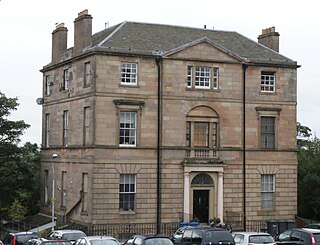
Viewfield House is a large square stone built three storey Palladian villa in Dunfermline, Fife, Scotland. It is a category B listed building.

Folkestone Town Hall, also known as The Guildhall, is a municipal building in Guildhall Street, Folkestone, Kent, England. The town hall serves as the headquarters of Folkestone Town Council, and also houses the Folkestone Museum. It is a Grade II listed building.
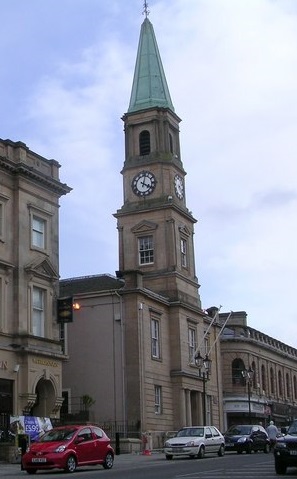
Airdie Town House is a municipal building in Bank Street, Airdrie, North Lanarkshire, Scotland. The town house, which was the headquarters of Airdrie Burgh Council, is a Category B listed building.
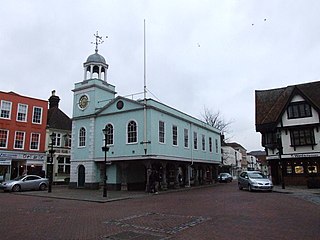
Faversham Guildhall is a municipal building in the Market Place in Faversham, Kent, England. The structure, which was the meeting place of Faversham Borough Council, is a Grade II* listed building.

Saltcoats Town Hall is a municipal building in Countess Street, Saltcoats, North Ayrshire, Scotland. The building, which is used by North Ayrshire Council as hub for the delivery of local services, is a Category B listed building.

The Shire Hall is a municipal structure in the High Street, Haverfordwest, Pembrokeshire, Wales. The shire hall, which was the meeting place of the old Pembrokeshire County Council, is a Grade II* listed building.

Falkland Town Hall is a municipal building in the High Street, Falkland, Fife, Scotland. The structure, which has been converted for use as offices and as shops, is a Category A listed building.
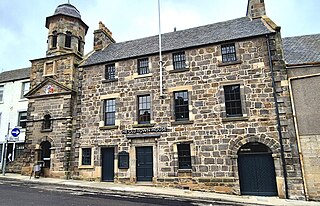
Inverkeithing Town House is a municipal building in the Townhall Street, Inverkeithing, Fife, Scotland. The structure, which is used as a base by members of the local community council, is a Category A listed building.

Pittenweem Parish Church and Tolbooth Steeple is an ecclesiastical and municipal complex in the High Street, Pittenweem, Fife, Scotland. The structure, which is used as the local parish church, is a Category A listed building.

Newburgh Town House is a municipal building in the High Street in Newburgh, Fife, Scotland. The structure, which is used as a series of artists' studios, is a Category B listed building.

Dreel Halls is a municipal complex in Elizabeth Place, Anstruther Wester, Fife, Scotland. The complex, which is used as a community events venue, consists of the former St Nicholas's Parish Church, which is a Category A listed building, and the former Anstruther Wester Town Hall, which is a Category C listed building.

Burntisland Burgh Chambers is a municipal structure in the High Street, Burntisland, Fife, Scotland. The building, which is the meeting place of the Burntisland Community Council, is a Category B listed building.
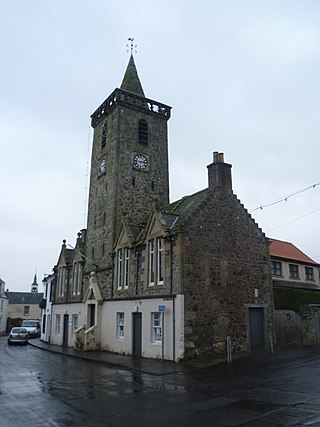
Auchtermuchty Town House is a municipal structure in the High Street, Auchtermuchty, Fife, Scotland. The structure, which accommodates the local public library, is a Category B listed building.

Inverness Town Steeple, formerly known as the Inverness Tolbooth, is all that remains of the former tolbooth on the High Street in Inverness, Scotland. The building, which is currently used to accommodate a private business, is Category A listed.






















